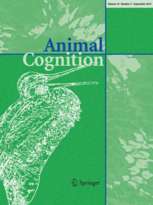Monkeys can point to objects they do not report seeing

Are monkeys, like humans, able to ascertain where objects are located without much more than a sideways glance? Quite likely, says Lau Andersen of the Aarhus University in Denmark, lead author of a study conducted at the Yerkes National Primate Research Center of Emory University, published in Springer's journal Animal Cognition. The study finds that monkeys are able to localize stimuli they do not perceive.
Humans are able to locate, and even side-step, objects in their peripheral vision, sometimes before they perceive the object even being present. Andersen and colleagues therefore wanted to find out if visually guided action and visual perception also occurred independently in other primates.
The researchers trained five adult male rhesus monkeys (Macaca mulatta) to perform a short-latency, highly stereotyped localization task. Using a touchscreen computer, the animals learned to touch one of four locations where an object was briefly presented. The monkeys also learned to perform a detection task using identical stimuli, in which they had to report the presence or absence of an object by pressing one of two buttons. These techniques are similar to those used to test normal humans, and therefore make an especially direct comparison between humans and monkeys possible. A method called "visual masking" was used to systematically reduce how easily a visual target was processed.
Andersen and his colleagues found that the monkeys were still able to locate targets that they could not detect. The animals performed the tasks very accurately when the stimuli were unmasked, and their performance dropped when visual masking was employed. But monkeys could still locate targets at masking levels for which they reported that no target had been presented. While these results cannot establish the existence of phenomenal vision in monkeys, the discrepancy between visually guided action and detection parallels the dissociation of conscious and unconscious vision seen in humans.
"Knowing whether similar independent brain systems are present in humans and nonverbal species is critical to our understanding of comparative psychology and the evolution of brains," explains Andersen.
More information: Andersen, L.M. et al (2013). Dissociation of visual localization and visual detection in rhesus monkeys (Macaca mulatta), Animal Cognition. DOI: 10.1007/s10071-013-0699-7
Journal information: Animal Cognition
Provided by Springer


















